The Ancient Skill of The Cobbler
Need a new pair of shoes? What do you do? Run down to the local shoe store or big box store and pick out a pair, right? Modern society has industrialized the making of shoes, just like everything else.
This saves us time and money as we don’t have to wait for bespoke shoes to be custom made to our specifications. While factory made shoes might not be as nice as custom made ones, they make up for it by being considerably cheaper.
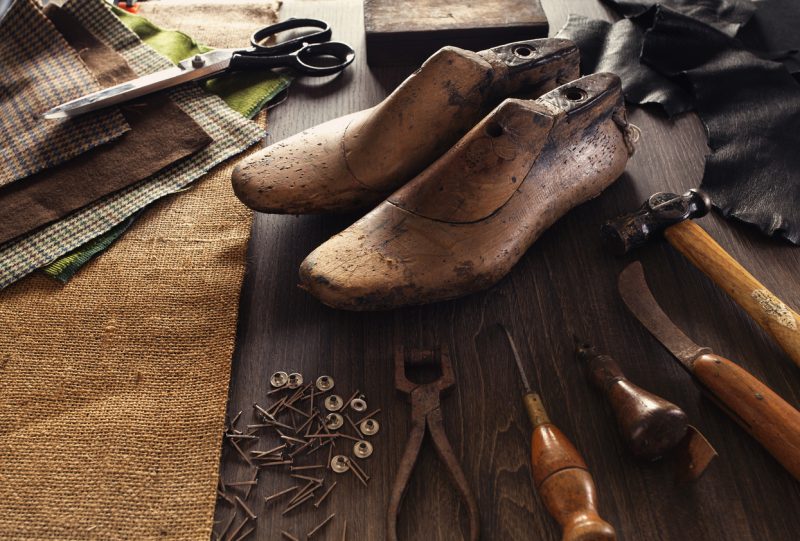
Before the industrial revolution hit, shoes were made by hand by the local cobbler. Even the early industrialization of shoe manufacturing still consisted of skilled workers who made shoes by hand. Mechanizing the process was slow and happened in a number of stages.
The local cobbler both made shoes and repaired them. People kept their shoes for much longer back then and had them resoled or reheeled as needed. The same shoes might be worn for 20 years or more, simply by replacing the soles and heels as needed. Of course, the shoe upper had to be much stronger and heavier to survive that; but these were made of top-grain cowhide and were intended to last a lifetime.
Making Shoes
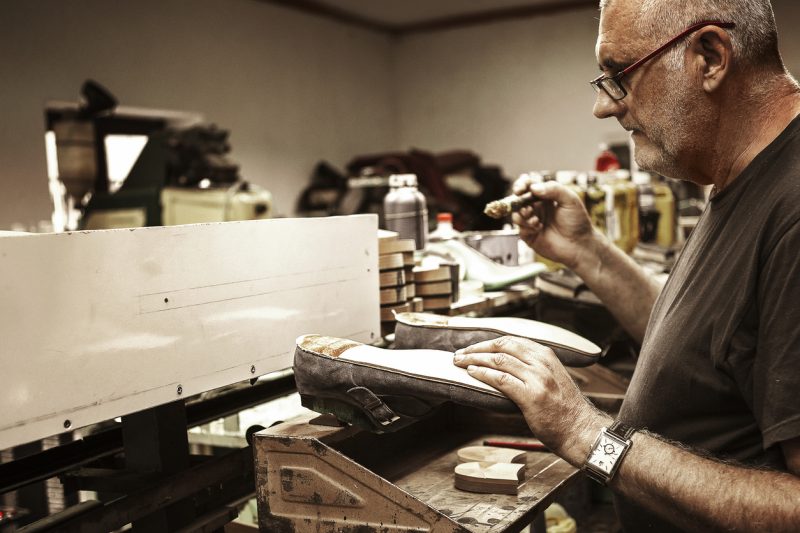
Shoes are actually rather complex and made of a number of different pieces. Almost all of the pieces have to be curved in some way for the shoe to take on its final appearance.
At times, the leather pieces are carved and filed to thin the edges. The pieces are held together through a combination of gluing (contact cement), stitching, and nailing (for the soles and heels). Some temporary nailing is done in the forming of the shoe, which is later removed.
Cobblers have quite a number of specialized tools that they use, which have been developed specifically for their trade. Even tools one would think would be “standard,” like hammers, aren’t as they have been adapted to the needs of cobbling.
Pretty much the entire process is done around a “last,” which is a carved wooden form made to match the user’s foot. Originally, a last was used only for the person who it was created for. As time went on, standard shoe sizes were developed, allowing for lasts that could be used for more than one customer.
Even then, different styles of shoes would require different lasts. A pointed toe shoe could not be made on a last for rounded toe shoes and vice versa. As the shape of the last becomes the shape of the finished shoe, that shape is critical.
Making the Upper
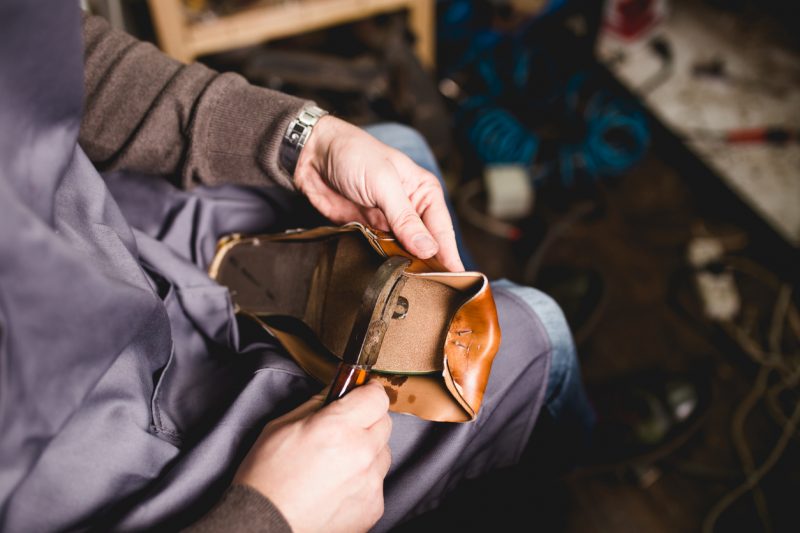
The shoe’s upper was actually the easiest part to make as the cobbler was working with softer, more flexible leather. A shoe upper typically consists of two layers – an outer and an inner one. The leather used for the outer layer is selected for its appearance and ability to polish to a high luster. On the inside, it is selected to be soft, subtle, and comfortable to wear.
How many actual pieces are used depends on the style of the shoe to be made. Some shoes, such as wingtips, have an overlay at the toe; this requires adding another piece. Likewise, the joining method can vary too. While the outer and inner layers are glued together, the various pieces and the edges of the pieces are all sewn.
As leather comes from living animals, it can have imperfections. In most cases, the cobbler would avoid those imperfections and save that leather for less visible spots.
But some minor imperfections could be smoothed out by scraping the surface with a scraper, much like a cabinetmaker used a scraper for creating a smooth finish before the use of sandpaper became common.
This was the first part of the shoemaking process which became mechanized, as the use of sewing machines was adapted to shoemaking fairly quickly. This saved time and reduced the skill level needed for the workers.
Lasting the Shoe
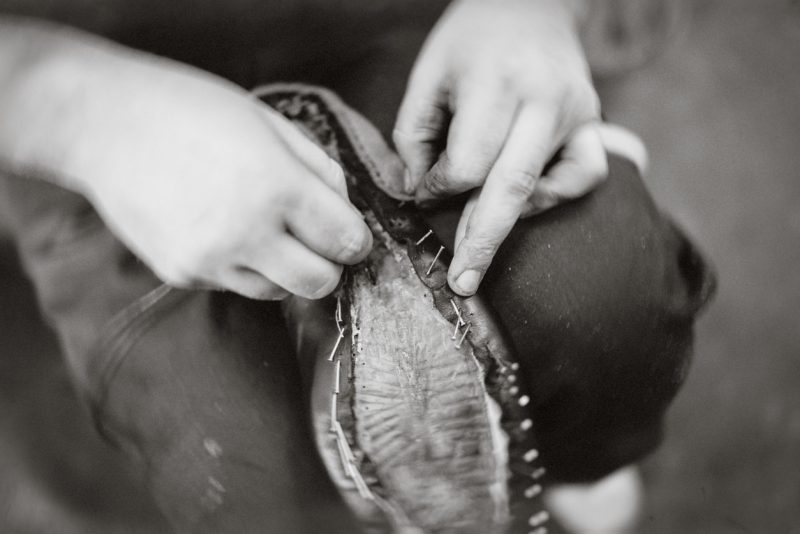
The most complicated part of making a shoe is lasting it. This is the process of bending the leather used for making the upper shoe around the last to where it is going to meet with the sole of the shoe. It can be said that the lasting process makes or breaks the shoe – in both appearance and quality.
This part of the process would require the work of the most skilled cobblers in a factory setting. The cobbler uses a pair of lasting pliers, which are specially designed to grip the leather and allow it to be pulled into shape around the last.
As it is pulled into place, a nail is placed through the two layers of leather and the shoe upper is temporarily nailed in place.
The hard part of lasting is the toe and heel. If you think about it for a moment, it’s clear that bending and stretching the leather around the curve of the toe is going to leave you with too much material on the bottom side. This has to be folded and shaped in such a way as to provide a smooth surface without any of the folds showing above where the sole is attached.
Once the shoe has been shaped, the nails are removed and the upper is glued to the innersole, making it one solid piece. Interestingly enough, when gluing the leather parts of a shoe, the parts are also hammered with a wide-face cobbler’s hammer.
This pushes out any air and compresses the leather slightly, ensuring a solid connection between the various pieces.
Even with this, the shoe is not yet ready for a sole. In order for the sole to attach firmly to the shoe, a smooth surface is needed, which the folding of the leather during lasting precludes. The cobbler would carve the folds with a sharp knife and then with a file to create a smooth surface.
Automating the process of lasting the shoe was the greatest challenge in industrializing shoe manufacturing. The problem was solved by Jan Matzeliger, a cobbler of Surinamese and Dutch descent, who patented his lasting machine in 1883.
With this machine, a non-skilled worker could last more than 10 times the number of shoes in one day that a skilled cobbler could. This immediately became a success, and the Consolidated Lasting Machine Company, which Matzeliger owned a large block of stock in, was formed to manufacture and market the tool.
Adding Soles and Heels
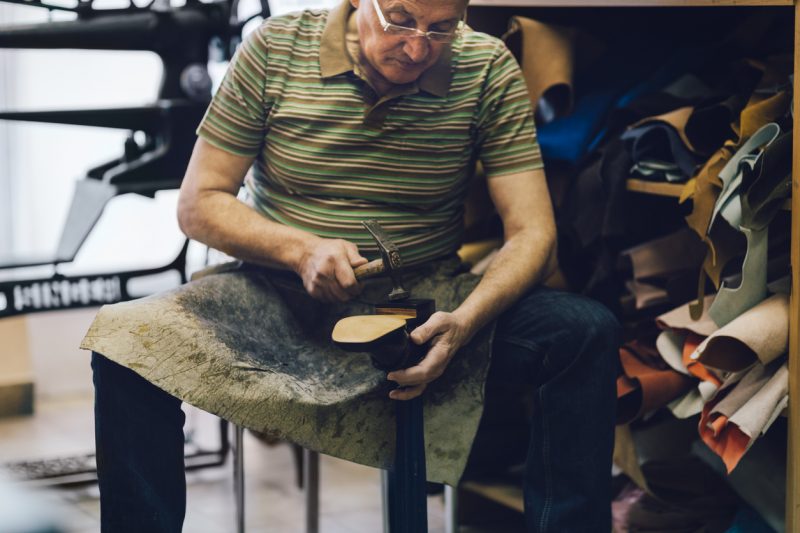
Traditionally, the soles and heels of shoes were made of leather, not the synthetic materials used today. The cobbler would build up the sole and then the heel in layers, starting with an edging around the perimeter of the shoe.
This is the textured portion you see when looking at the top of the sole of a leather-soled shoe. This edging is matched with a center filler piece, kind of a second insole, to make a level surface.
Depending on the design of the shoe, at least two more layers of leather are added to create the sole. These are generally stitched to the edging. With hobnail shoes, this was actually nailed to the shoe upper using small tacks made of wood (think the broken-off end of a round toothpick).
The heel of the shoe is made just like the sole – by adding additional layers until the full height of the heel is reached. The last layer is nailed in place with a less tacky glue so that it can be removed and replaced when needed. A very thick, hard leather is used for the heels.
The edge of the sole has to be shaped perfectly. This is done first with a sharp knife, then with a file, and finally with a scraper. The scraper is also used along the sole and bottom of the heel to remove imperfections and smooth out the final surface.
Sole and heel manufacture was greatly improved, saving considerable time, through mechanization. The edges of the soles and heels could be sanded with drum sanders rather than hand shaped with a knife and file. If you go to a cobbler today (if you can find one) to have your shoes resoled or reheeled, you will see them shape the edges in this manner.
The other thing that industrialization did for shoe manufacturing was to introduce the use of heavy-duty sewing machines for the stitching of shoe soles. While not a complex process, this was a tedious one that required a lot of hand strength.
Cobbling in a Survival Situation
Cobbling is a highly specialized trade that takes years to learn. This doesn’t, however, mean that we should totally ignore the work of the cobbler in a survival situation. We will need footwear to protect our feet, and the footwear that we have probably won’t last.
The things that are most likely to wear out in any pair of shoes or boots are the soles and heels. Fortunately, it is relatively easy to replace these if we have the necessary leather and a few rudimentary tools. These are the type of punches and stitching tools that anyone who has done leatherwork is likely to have.
Of course, not all modern shoes can be resoled or reheeled. The sole must extend out beyond the sides of the shoe upper to do this, as with most dress shoes. Tennis shoes wouldn’t work.





